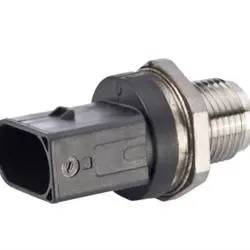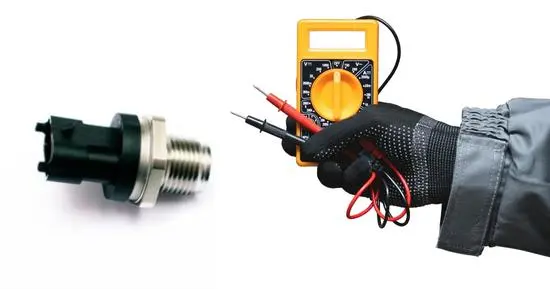This article provides information on how to test the fuel pressure sensor in a fuel injection system with a multimeter. A fuel pressure sensor is critical in distributing fuel from the fuel tank to make an air-fuel mixture that runs your vehicle smoothly.
A fault in the fuel pressure sensor can lead your vehicle to varying speed (acceleration), poor fuel economy, and stalling the engine. So you must test the fuel pressure sensor with a multimeter or any tool that can be used to measure voltage.
Below, we’ll discuss working, faults’ symptoms, and fuel sensor testing.
Table of Contents
ToggleHow Does Fuel Pressure Sensor Work?
A fuel pressure sensor is installed inside or out of the fuel tank. It calculates the pressure on the fuel going from the fuel tank to the engine. The fuel pressure sensor measures pressure on the fuel and communicates with the engine control unit, and operates the fuel pump to pump the fuel (pressure).
A fuel pressure sensor will check the fuel pressure and identify any leaks that reduce the fuel pressure. However, a fuel rail is designed to deliver the required fuel for a specific time.
The pressure in the fuel sensor affects the sensor’s resistance and results in a drop or hike in voltage. ECU reads these voltage signals that takes appropriate action, such as an increase or decrease in fuel pressure, depending on the acceleration.
If the fuel pressure sensor is faulty, it’ll share false readings with the ECU. Abnormal reading will result in undesired fuel pressure affecting the acceleration and economy of your vehicle.
A poor fuel sensor will affect the air-fuel mixture ratio, leading to the variable, weak acceleration, and stalling engine in severe cases.
Driving with a malfunctioning fuel pressure sensor can adversely impact your engine’s performance. You can run your car without a fuel pressure sensor, but only for a very short time.
The fuel pressure sensor monitors the fuel pressure and sends the information to the Engine Control Unit.
The control unit then operates the injectors (fuel pump) to maintain pressure according to the current requirement.
Signs of bad fuel rail pressure sensor:
Due to an imbalanced air-fuel mixture, your car may change or have weaker acceleration than before.
A poor fuel mixture results in decreased fuel mileage as the fuel pressure is affected.
The engine will have trouble starting and ceases in the worst conditions.
Unrealistic reading by the fuel pressure sensor will affect the fuel mixture ratio resulting in poor acceleration.
How to test fuel pressure sensor with a multimeter
To test the fuel tank pressure sensor, locate and disconnect it from the connector. Set your multimeter to DC voltage.
Measure the voltage in the signal wire when the engine is off(vehicle on) and after starting the engine. Also, test voltage in the fuel pressure sensor’s power wire (input).
Check continuity in the power (hot) wire to the battery’s positive terminal and from the ground wire to the battery’s negative terminal.
Compare the multimeter reading with the ideal voltage of your fuel pressure sensor.
-
Locate the fuel pressure sensor:
To test your vehicle fuel pressure sensor, locate it first. The fuel pressure sensor is part of the evaporative emissions system and is located inside or on the top of the fuel tank.
A fuel rail pressure sensor can also be located under the hood near the fuel rail.
-
Test the sensor while installed on the vehicle:
Check the continuity between the live sensor wire (yellow) and the battery-positive terminal. Also, check the continuity from the ground wire in the sensor connector (green) to the negative battery terminal.
If the sensor connector is fine, both wiring connections should have excellent continuity or minimum resistance.
Suppose you get low voltage in the fuel pressure sensor’s connector; test continuity in the sensor wires and the ECU. If there is high resistance (low continuity) between the sensor wires and the ECU, the wiring between the sensor and the ECI is faulty.
-
Test the fuel pressure sensor after disconnecting it:
Disconnect all wiring (harness) from the sensor and unplug it from the vehicle. If you cannot disconnect the fuel sensor, consult the manufacturer’s manual or search YouTube.
After disconnecting the fuel pressure sensor, turn on the vehicle engine.
To test 3 wire fuel pressure sensor, you’ll see a ground (green), 5V live (yellow), and signal wire (brown). In the fuel pressure sensor plug, the terminals at the left and right corners are for input (live), and the ground and the central terminal are for the signal wire. Set your multimeter to DC volts.
Attach the red probe to the live/input wire and the black probe to the ground wire in the fuel pressure sensor connector.
A fine fuel sensor connector should have around 1.2 volts at idle that increase up to 3 volts as the vehicle runs. However, you should compare the multimeter reading with the ideal voltage range mentioned in the car’s manual, as different models can have different values.
Test voltage in the live and signal wire of the sensor by taking the negative battery terminal.
Also, test the voltage in the signal wire by placing the red probe on the signal wire and the black probe on the negative battery terminal. Compare the voltage readings with the ideal range of your car’s model.
-
Evaluate your fuel pressure sensor:
In an ideal fuel pressure sensor, the signal wire should have less than 1V when tested with the engine on. The sensor has been shorted if the signal wire is reading around 5V.
Turn on the ignition key without starting the engine. Test the voltage of the signal wire by placing the red probe at the signal wire in the fuel pressure sensor and the black wire to the negative battery terminals.
The multimeter will read around .5 volts when the engine is off. While the multimeter probes connected to the signal wire and battery’s terminal, turn on the engine.
When the engine is cranking, you’ll see voltage surges, and as you increase the RPM (press the accelerator), the voltage will rise and then return to normal after you release the accelerator.
It means that the voltage reading in the signal wire increases as you press the accelerator. This information is transmitted to the ECU to respond according to the sensor readings.
The sensor’s signal wire is assigned to share the fuel pressure information with the sensor. A fault such as a short in the signal wire makes the fuel pressure sensor measure inaccurate readings that impact your vehicle’s fuel mixture and mileage.
Conclusion:
A fuel pressure sensor plays a significant role in fuel injection from the fuel tank to the engine. So a fuel pressure sensor must be tested regularly after a time interval to keep your engine running smoothly. You can evaluate a fuel pressure sensor by measuring voltage in the sensor connector wires.
Follow the complete guide above to test your vehicle’s fuel pressure sensor.
If you still find something difficult, ask us in the comment section.
Related Guides:




